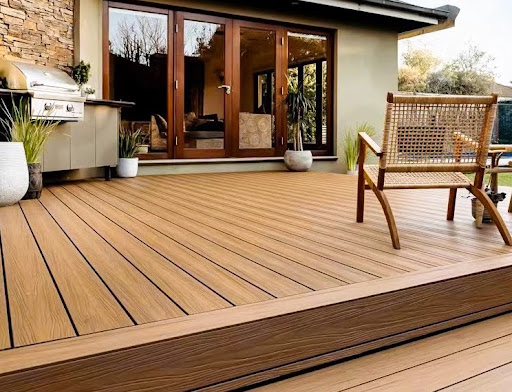Introduction
Wood‑plastic composite (WPC) decking is redefining outdoor living worldwide. By marrying finely milled, reclaimed wood fibers with recycled polyethylene, modern manufacturers produce boards that mirror the warmth of timber yet resist rot, splinters, and insect damage for decades. The result is a surface that stays cool underfoot, cleans up with only soap and water, and never needs staining. For homeowners passionate about home improvement, committed to environmental stewardship, or simply eager to elevate their home décor with contemporary lines, understanding how WPC is formulated, tested, and installed is critical.
This comprehensive guide explores the material science, manufacturing ethics, and design flexibility behind today’s best WPC products, equipping you with actionable insights to select decking that satisfies both aesthetic ambitions and practical demands. From long‑term cost comparisons to color fastness ratings, we cover every factor that should influence a confident purchase decision.
What Makes WPC Composite Decking a Smart Choice?
Every project starts with understanding value, and value is built at the factory floor. Partnering with a reliable wpc composite decking manufacturer grants access to boards engineered for dimensional stability, slip resistance, and long‑term color retention. Such companies blend uniformly sized wood flour with pigments and UV inhibitors, then extrude the mix through precision dies so each plank emerges straight and stress‑free. Because moisture uptake is minimal, warping and cracking familiar to pressure‑treated lumber are eliminated.
Accelerated weather testing confirms that performance claims translate to real backyards. For homeowners, this rigorous process converts into lower maintenance budgets, fewer repair weekends, and a deck that consistently complements surrounding landscaping and architectural style. Ultimately, a well‑vetted supply chain equates to everyday peace of mind, letting families focus on enjoyment rather than upkeep.
Comparing WPC and Traditional Wood: Performance and Longevity
Classic timber boards have served terraces for centuries, yet they carry inherent vulnerabilities that can drain both time and wallets. Softwoods—even when pressure‑treated—must be sealed every couple of years to block mildew, while exotic hardwoods demand specialized oils to preserve their signature hues. By contrast, WPC’s polymer matrix forms a continuous barrier around each wood particle, preventing fungal spores from nesting and moisture from swelling fibers.
Thermal expansion is predictable and limited, so planks stay straight across scorching summers and icy winters. Independent studies demonstrate that quality composite decking maintains tensile strength above 25 MPa after ten simulated years of ultraviolet exposure, whereas untreated cedar loses nearly half of its load‑bearing capability. Equally important, capped composites feature a co‑extruded outer shell that resists juice and grease stains—an advantage for outdoor kitchens—and cleans with a garden hose instead of harsh solvents. These advantages translate to a lifecycle cost that typically beats wood within five to seven years of installation.
Environmental Advantages of Recycled Wood‑Plastic Composites
Environmental metrics often determine whether a project qualifies for green‑building incentives or satisfies a homeowner’s personal ethos. Well‑established composite plants divert mountains of sawdust and post‑consumer plastic film from landfills each year, turning what was once waste into valuable construction material. Because the wood fibers are already kiln‑dried, extrusion consumes less energy than milling fresh lumber, yielding a smaller carbon footprint per square meter of decking.
Moreover, many factories operate closed‑loop water systems and reclaim process heat, further improving efficiency. Crucially, composite production eliminates the demand for tropical hardwoods sourced from fragile rainforests, slowing deforestation and preserving biodiversity. End‑of‑life pathways are also evolving; off‑cut pieces and demo boards can be reground and reintroduced into new product cycles, creating a circular economy that traditional decking cannot replicate. For eco‑conscious consumers, selecting WPC is therefore a pragmatic step toward reducing household environmental impact without compromising on style or longevity.
Choosing the Right WPC Boards for Your Climate
Not all composite formulas behave identically, and matching board specification to local weather maximizes performance. Start by analyzing temperature ranges, annual rainfall, and exposure to salt or chlorinated water. A seasoned wpc decking manufacturer will offer multiple product series, each engineered with tailored pigment packages, UV inhibitors, and cap‑layer thicknesses to suit specific environments. In high‑heat regions, lighter shades and hollow‑core profiles minimize surface temperatures, keeping decks barefoot‑friendly during peak sun hours.
Conversely, snowy climates benefit from solid‑core planks that tolerate freeze‑thaw cycles without micro‑cracking. Coastal homeowners should prioritize stainless steel hidden fasteners and corrosion‑resistant substructure clips to combat salty air. Some brands publish detailed coefficient‑of‑thermal‑expansion charts, empowering installers to leave accurate gapping. By aligning board technology with meteorological realities, you not only preserve color vibrancy but also extend structural warranties, ensuring peace of mind through every season. Beyond climate considerations, evaluate traffic patterns—pets, children, furniture movement—to choose surface textures that balance slip resistance with easy cleaning.
Design Possibilities: Colors, Textures, and Layout Patterns
Contemporary composite collections read like designer palettes, offering earthy browns, sun‑washed grays, and ultra‑modern charcoal blacks, many with multi‑chromatic streaking that mimics exotic hardwood grain. Multiple board widths—narrow, standard, and wide—allow installers to craft intricate layouts such as herringbone, chevron, or picture‑frame borders that visually expand small courtyards. Embossed textures range from fine brushing that resembles weathered cedar to deep wire‑brushing that channels reclaimed barn wood. Accents such as matching fascia, stair treads, and privacy screens maintain color continuity throughout the outdoor living space.
Pairing contrasting tones—think slate gray field boards with silvered driftwood borders—adds architectural drama without sacrificing harmony with surrounding stone or siding. Manufacturers are also introducing integrated LED groove lighting and modular planter systems that click into deck boards, transforming simple platforms into multifunctional retreats suitable for quiet morning yoga or evening entertainment. The result is an exterior space that feels curated rather than simply constructed.
6. Installation and Maintenance Tips for Lasting Beauty
While composites simplify ownership, thoughtful installation remains vital. Begin with a rigid substructure built from galvanized or aluminum joists to eliminate the risk of hidden rot. Follow manufacturer spacing guidelines—generally 300 mm on‑center for residential applications—and fasten planks with hidden clip systems that permit seasonal expansion while eliminating surface screws. Always stagger board ends at least two joists apart to distribute load and create a more natural pattern.
During cutting, use carbide‑tipped blades and support boards fully to avoid chipping the cap layer. Post‑construction cleaning is refreshingly straightforward: sweep away debris, occasionally rinse with a garden hose, and use a pH‑neutral soap solution for oil spills within 48 hours. Avoid abrasive cleaners and metal shovels, which can scratch protective surfaces, and remember to clear autumn leaves promptly to prevent tannin staining. By observing these simple habits, homeowners can expect the deck’s initial luster to endure well beyond its generous warranty period.
Conclusion
Investing in WPC decking harmonizes sustainability, style, and long‑term savings. From the moment boards leave the extrusion line to the day they grace your garden party, the engineering behind composite planks delivers measurable advantages over traditional wood. Armed with knowledge about manufacturing rigor, environmental benefits, design versatility, and care routines, you are ready to select a product line that complements both local climate and personal taste.
Remember to request product datasheets, review third‑party certifications, and, whenever possible, visit existing installations for tactile confirmation. For more details and visual inspiration, please visit the official site and begin planning an outdoor space that will remain inviting year after year. And because leading composite brands back their lines with multi‑decade warranties, your investment remains protected against the unexpected.



